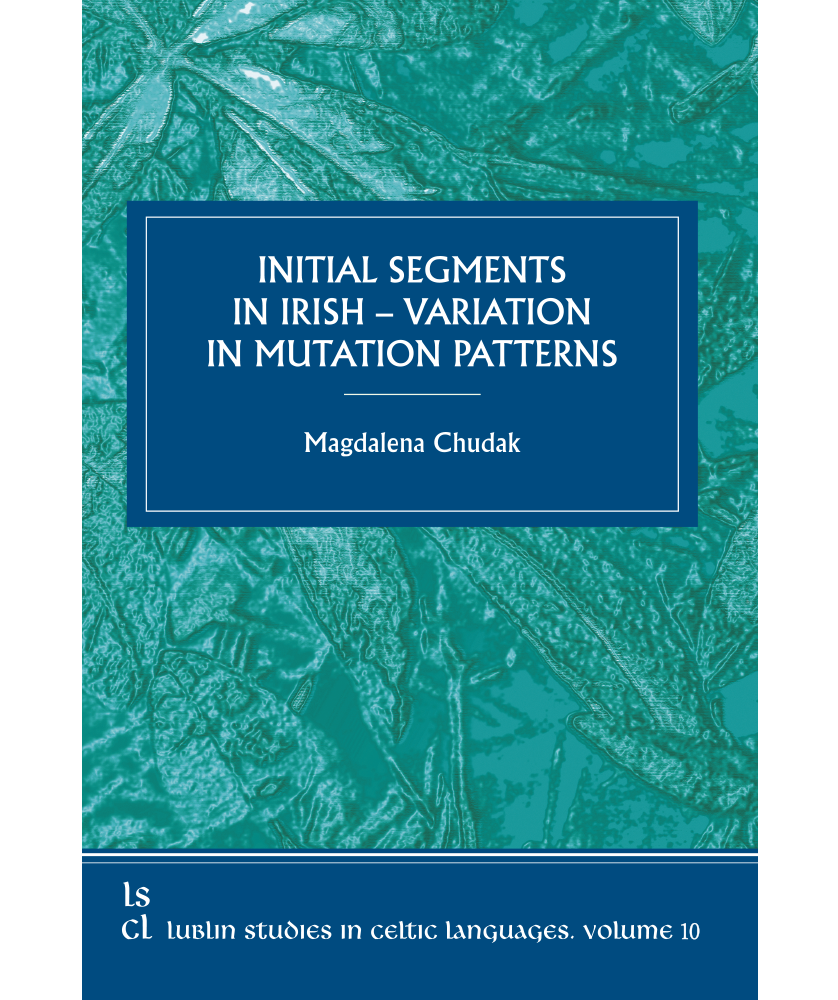


Studies in Literature and Culture. Volume 10
Magdalena Chudak
ISBN: 978-83-8288-031-1
Stron: 228
Format: B5
Rok wydania: 2022
Table of Contents (Spis treści)
Acknowledgements
Table of Contents
List of Abbreviations
Introduction
CHAPTER 1
Preliminaries
1. The alteration of word-initial segments – a presentation of the problem
2. Celtic languages
3. Initial segments in Irish
3.1. Consonants
3.2. Consonantal clusters
3.3. Vowels
4. Consonant mutations in Irish
4.1. Introduction
4.2. Lenition
4.2.1. The effects of lenition
4.2.2. [s] > [t] replacement
4.2.3. Lenition contexts
4.3. Eclipsi
4.3.1. The effects of eclipsis
4.3.2. Eclipsis contexts
4.4. Prevocalic consonant prefixation
4.4.1. Introduction
4.4.2. [h]-prefixation (pre-vocalic aspiration)
4.4.3. [t]-prefixation
4.4.4. [n]-prefixation (pre-vocalic nasalisation)
4.5. Mutations in Irish – diachrony
4.5.1. Lenition and eclipsis
4.5.2. [s] > [t] replacement
4.5.3. [h]-insertion
4.5.4. [t]-insertion
4.5.5. [n]-insertion
4.5.6. Conclusion
4.6. Mutations in the word-based morphology model
4.6.1. Word-based morphology
4.6.2. Previous accounts of mutations in the word-based morphology model
4.6.3. Mutation schemas
5. Conclusion
CHAPTER 2
Terminology and the Scope of Research
1. Introduction
2. Interchange or alteration: two descriptive approaches
2.1. Interchange
2.2. Alteration
2.3. Mutation schemas revisited
2.4. Mutation schemas versus alteration patterns
2.5. Conclusions: the terminology
3. Data and data collection
3.1. The criteria
3.1.1. Broad/slender interchange
3.1.2. The rest of the word
3.2. Methodology
3.2.1. Sources
3.2.2. Some problems regarding the direction of motivation
3.2.3. The appendix: the corpus of word-pairs
4. Conclusion
CHAPTER 3
Alteration Patterns Based on Mutations
1. Introduction
2. Previous accounts of the alteration patterns based on mutations
2.1. Fowkes: ‘Mutational replacive metanalysis’
2.2. Hannahs: ‘Mutational ambiguity resulting from mutation patterns’
2.3. Kelly: ‘Psychological effects of mutations’
3. Mutation contexts: dialectal differences and their implications
4. Alteration types based on mutations
4.1. The mutation system as a source of confusion
4.2. Typology of mutation-based alterations
4.3. Radicalisation
4.3.1. General mechanism
4.3.2. Radicalisation patterns based on eclipsis
4.3.2.1. [p]→[b] radicalisation
4.3.2.2. [b]→[m] radicalisation
4.3.2.3. [k]→[g] radicalisation
4.3.2.4. [t]→[d], [d]→[n], and [ø]→[n] radicalisation
4.3.3. Radicalisation patterns based on lenition
4.3.3.1. [p]→[f] radicalisation
4.3.3.2. [s]→[t] radicalisation
4.3.3.3. [f]→[ø] radicalisation
4.3.3.4. [g′]→[ø], [d′]→[ø], and [g′]→[l′] radicalisation
4.4. Deradicalisation
4.4.1. General mechanism
4.4.2. Deradicalisation patterns based on eclipsis
4.4.2.1. [m]→[b] deradicalisation
4.4.2.2. [d]→[t] deradicalisation
4.4.2.3. [b]→[p], [n]→[d], and [g]→[k] deradicalisation
4.4.3. Deradicalisation patterns based on lenition
4.4.3.1. [ø]→[f] deradicalisation
4.4.3.2. [f]→[p] deradicalisation
4.4.3.3. [ø]→[g] and [ø]→[d] deradicalisation
4.5. Misradicalisation
4.5.1. General mechanism
4.5.2. Misradicalisation patterns based on lenition
4.5.2.1. [m]→[b], [b]→[m] misradicalisation
4.5.2.2. [g]→[d], [d]→[g] misradicalisation
4.5.2.3. [t]→[s], [s]→[t] misradicalisation
4.5.2.4. [s]→[p] misradicalisation
4.5.3. Misradicalisation patterns based on lenition and eclipsis
4.5.3.1. [m]→[f] misradicalisation
4.5.3.2. [b]→[f], [f]→[b] misradicalisation
5. Conclusion
CHAPTER 4
Alterations Based on Other Processes
1. Introduction
2. Sources of secondary initials
2.1. Phonetically conditioned alterations
2.1.1. Palatal stops
2.1.1.1. Realisations of palatality in the northern dialects
2.1.1.2. Realisations of palatality in the western and southern dialects
2.1.1.3. Articulation of palatals as a source of confusion
2.1.1.4. Perception of palatals as a source of confusion
2.1.2. Other minor phonetic changes
2.1.2.1. [b]→[p] alteration as a phonetic change
2.1.2.2. [p]→[b] alteration as a phonetic change
2.2. Phonaesthesia – the semantic conditioning of consonantal alterations
2.2.1. [p]-prefixation
2.2.2. The insertion (and deletion) of the initial s-
2.2.2.1. Prosthetic s- in Irish
2.2.2.2. Prosthetic s- in Swedish and English
2.2.2.3. The schm-/shm- phonaestheme in (American) English
2.2.2.4. The phonaestheme sr- in Polish
2.3. Alteration as a lexically conditioned change
2.3.1. Metanalysis
2.3.1.1. Movable n- in Irish
2.3.1.2. Movable t- in Irish
2.3.2. Other changes
3. Conclusions
Conclusions
References
Internet Sources
Appendix